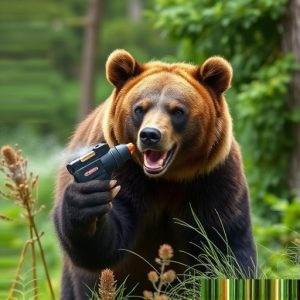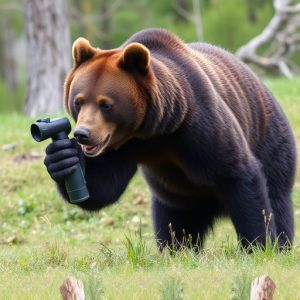Optimizing Bear Safety: Alaska Bear Spray’s Fog Pattern & Capsaicin Power
Maximizing bear spray defense involves understanding its unique fog pattern, which evenly distribute…….
Maximizing bear spray defense involves understanding its unique fog pattern, which evenly distributes capsaicin (the active ingredient) over a 30-foot range. This mist targets bears' sensitive areas, irritating their eyes and respiratory system. Higher capsaicin concentration enhances repellency and range, while proper usage techniques ensure optimal protection during encounters in bear country.
In the vast landscapes of Alaska, understanding bear spray fog patterns is crucial for safety. This guide delves into the science behind bear spray, focusing on how its unique fog pattern enhances efficacy. We explore the key role of capsaicin concentration in bear repellent, providing insights to ensure maximum protection. From decoding product labels to mastering application techniques, these best practices will empower you to navigate Alaska’s wilderness with confidence.
- Understanding Bear Spray Fog Pattern and Its Efficacy
- Decoding Capsaicin Concentration in Bear Repellents
- Best Practices for Using Alaska Bear Spray Effectively
Understanding Bear Spray Fog Pattern and Its Efficacy
Understanding the bear spray fog pattern is crucial for ensuring its efficacy as a defense mechanism against bears. When a bear repellent spray creates a fog, it’s because the liquid transforms into tiny droplets suspended in the air—a mist-like effect. This unique delivery system allows the active ingredient, capsaicin, to spread widely and envelop both the attacker and the user in a protective layer. The fine droplets ensure that the capsaicin concentration in bear repellent is evenly distributed, maximizing its irritant effects on the bear’s sensitive eyes, nose, and respiratory system.
The fog pattern also compensates for the unpredictable behavior of bears. Unlike direct spraying, which might miss or irritate the user, the fog envelops the area in a cloud of capsaicin, providing a safer and more reliable defense. This method is particularly effective in close-quarters encounters where direct contact with a bear might be unavoidable. The fog pattern acts as a shield, giving users precious time to retreat or fight back while minimizing their own exposure to bear attacks.
Decoding Capsaicin Concentration in Bear Repellents
The effectiveness of bear spray lies in its capsaicin concentration, a key factor to understand when guarding against potential encounters. Capsaicin, the active ingredient found in chili peppers, is what creates the burning sensation and drives bears away. Bear repellent manufacturers measure this component in parts per million (ppm), indicating the potency of the spray. A higher ppm means more capsaicin, resulting in a longer range and stronger repellency. However, it’s not just about strength; the pattern of fog released also plays a crucial role. The ideal bear spray creates a dense, fine mist that covers a wide area, ensuring maximum exposure to the bear’s eyes, nose, and fur.
Decoding the capsaicin concentration helps users make informed choices tailored to specific environments and situations. For example, higher ppm values might be suitable for dense forests where encounters with aggressive bears are more probable. Conversely, lower concentrations could suffice in areas with less frequent bear activity or for recreational activities that don’t require extended protection. Understanding these nuances ensures individuals carry the right equipment, enhancing safety during outdoor adventures in bear country.
Best Practices for Using Alaska Bear Spray Effectively
When it comes to using Alaska bear spray, understanding its fog pattern and best practices is key for effective protection. The spray creates a dense fog that can reach up to 30 feet, making it essential to aim for the bear’s face and eyes—the sensitive areas most affected by capsaicin, the active ingredient in bear repellent. It’s important to note that the spray’s range and effectiveness depend on proper usage; spraying too high or too low can reduce its impact.
The capsaicin concentration in bear spray plays a significant role in its performance. Higher concentrations provide longer-lasting protection, giving you more time to escape. However, it’s crucial not to over-spray, as this can waste valuable product and decrease the overall effectiveness. Practice makes perfect; familiarizing yourself with the spray’s mechanism and range will ensure you’re prepared should you encounter a bear in the wild.
When navigating Alaska’s wilderness, understanding the bear spray fog pattern and utilizing it effectively is crucial. Deciphering capsaicin concentration levels in bear repellents ensures optimal protection. By adhering to best practices, including proper usage techniques and choosing the right product, adventurers can significantly reduce bear encounters’ risk. Remember, knowledge of local conditions and preparation are your best allies when exploring these majestic landscapes.


